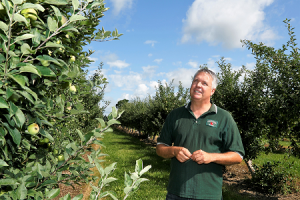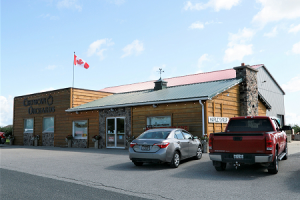Growing Into the Future
Adapting to changing economics, consumer tastes and technology, a family apple farm succeeds against the odds
Photo: Crunican Orchards owner, Phil Crunican
IF YOU WANT to introduce a new type of apple to your orchard, you’re looking at about a decade-long process. Two years to grow the sapling, seven or eight more until the tree matures. Selling apples requires an awful lot of preamble, so the industry has generally been a pretty static one.
But the apple farming industry, says Phil Crunican, fourth generation owner of Crunican Orchards north of the city, does indeed change.
“Twenty-five years ago, 75 or 80 per cent of what we grew went out the door wholesale,” he says—sold, in other words, to packers who then supply grocery stores and other commercial operations. “Now, it’s totally flipped. We’re selling 85 to 90 per cent out the front door.”
For Crunican, it’s the most recent evolution to a family business that has been in operation since 1877.

Like other agricultural sectors, the apple business has been bruised by rising labour costs and a shortage of workers. Apple production is characterized by intensive labour use—manual work is required for pruning, fruit thinning and harvest. Crunican says labour costs can consume up to 70 per cent of his operating budget.
Crunican says as competition for wholesale apples was getting more and more intense in the 1990s, the operation made the decision to focus more on retail sales and farmgate marketing, selling directly to the consumer, food operators and independent retailers.
But make no mistake: Crunican Orchards is still a dedicated farming operation. It’s been able to resist the pull to convert to what Crunican calls “entertainment farming”—the kind of orchard where visitors pay a door price for pick-your-own apples and where much of the focus is on recreation features such as hayrides, mazes, petting zoos and harvest festivals.
“That push to buy local, it was an amazing turn for the Ontario apple industry as a whole” —Phil Crunican
Crunican understands why other operators might choose to go down that road, but it’s not for him. “That’s what some of small guys are trying to do to keep themselves afloat,” he says.
Nonetheless, all apple orchards need to keep evolving and investing to stay in operation. Sprawling trees, for example, have been replaced by an investment in smaller, more productive ones that result in higher-density orchards.
Crunican says the competitive demands on small fruit farming operations has taken its toll on the industry. “A lot of little apple growers have gotten out of the business since the mid-90s,” he says. “There’s only two or three of us left [in the London area] now.”
It was the farm-to-table movement that, a little over a decade ago, gave a serious boost to Crunican Orchards. “[The] buy local [movement] really helped us when it came around 10 to 15 years ago,” Crunican says. “That push to buy local, it was an amazing turn for the Ontario apple industry as a whole.”

The growing consumer demand for local food not only helped Crunican Orchards redefine its operation, it continues to influence how the operation looks to the future. “There’s lots of things you can do on the retail side, and that’s the goal now,” Crunican explains. “Whether it’s putting a bakery in or a hard cidery or whatever. That’s the next step.”
For now, though, things remain pretty simple. The orchard sells 15 different varieties “to keep everybody happy,” says Crunican. “Everybody likes a certain type of apple.”
And while there will always be new challenges to grapple with—climate change, consumer trends, bee population and worker shortages to name a current few—Crunican says the apple business has always been about making long-term practical decisions, and as long as the farm continues to adapt and respond, there will always be a way to succeed .
“Everybody else is closed up,” he says, matter-of-factly. “So, we’re a survivor.” ![]() Kieran Delamont
Kieran Delamont

